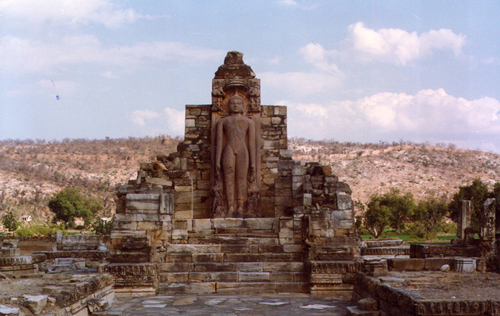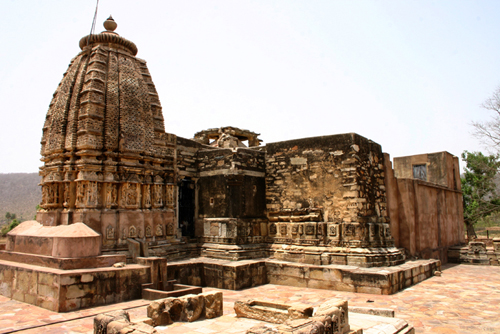The site of Neelkantha, known after the deity Siva enshrined in this temple, was anciently known as Rajyapura and later Paranagar. The temple is a three-shrined complex of which the central one facing west and dedicated to Siva-linga, has preserved its full elevation including sikhara, while the lateral shrines are now bereft of their superstructures. The three shrines are pancharatha and share a common rangamandapa, supported on four central pillars and preceded by a porch. The temple has a pitha which supports a vedibandha with niched figures. The jangha of the central shrine bears figures of Narasimha (north), Harihararka (east) and Tripurantaka (south) on the bhadra niches and those of surasundaris and dikpalas on other projections. The rangamandapa has a concentric ceiling of coffered cusps of the padmasila type while all the pillars are laden with figural ornaments of surasundaris and gandharvas in multiple zones. While the door-frame of the central shrine has Natesa as the lalatabimba, the lateral shrines have lost all indications of their attribution. The temple is assignable to the fag end of the tenth century A.D. and was built by Maharajadhiraja Mathanadeva, a local Pratihara feudatory, as stated in an inscription dated A.D. 961. Besides Neelkantha temple, the site has other shrines are now in dilapidated condition, Bataka-ki-Deori, Kotan-ki-Deori, Lachholava-ki-Deori, Dabar-ki-Deori, Hanuman-ki-Deori, Bagh-ki-Deori and Naugaja temple are important among them.
Naugaja or Temple of Santinatha is situated about 100 m west of the Neelkanth. Stands on high jagati consists of sanctum and miniature shrines on the sides. A colossal image of Jaina tirthankara Santinatha stands in the sanctum. An inscription preserved in National Museum records that the temple dedicated to Santinatha was built on the 13th day of the dark half of Baisakha in the year VS 979 (AD 922-23) during the reign of Gurjar Pratihar Mahipala Deva of Kannauj and the architect was Sarvadeva of simhapadra.
| Notification No. | Act No. LXXI of 1951 dated 28.11.1951 |
| Notification in PDF | |
| Ownership Status | Government |
| Topographical Features | Situated in a forest area surrounded by hills. |
| 1 | K.C. Jain, Ancient Cities and Towns of Rajasthan (Delhi 1972); |
| 2 | M.A. Dhaky (ed.), Encyclopaedia of Indian Temple Architecture, North India, Beginning of Medieval Idioms (New Delhi 1998); |
| 3 | Chandramani Singh (ed.), Protected Monuments of Rajasthan (Jaipur 2002) and |
| 4 | Neelima Vashishtha, Sculptural Traditions of Rajasthan (Jaipur 1989). |
| Locality | Tehsil | District | State |
| Neelkanth (Lat. 27o 15’ N; Long. 76o 21’ E) | Rajgarh | Alwar | Rajasthan |
District





 By Air : Jaipur
By Air : Jaipur By Bus : Alwar
By Bus : Alwar By Train : Tahla
By Train : Tahla